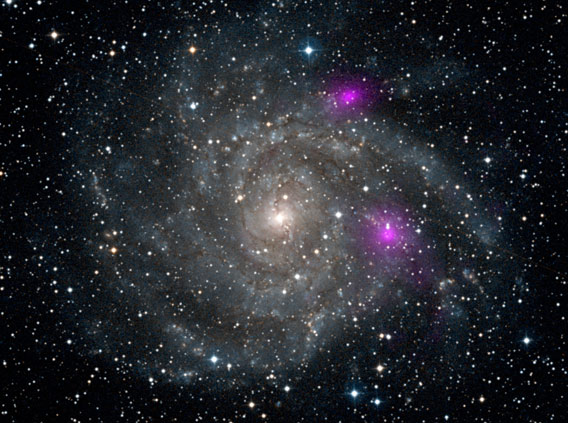Create a free profile to get unlimited access to exclusive videos, sweepstakes, and more!
NuSTAR’s Glimpse of Cosmic Violence

On June 13, 2012, NASA launched a revolution into orbit: NuSTAR, a telescope that sees some of the highest-energy light created by the most violent events in the Universe. NuSTAR stands for Nuclear Spectroscopic Telescope Array, and itâs designed to detect and actually make images from X-rays, something thatâs very hard to do for a telescope. It had never been done before for the very highest energy X-rays, which is just what NuSTAR was designed to do. At this weekâs meeting of the American Astronomical Society, two new images and scientific results were released from NuSTAR.
The first, seen at the top of this post, shows the location of two black holes (in purple) in the nearby spiral galaxy IC 342 (one of my favorite galaxies in the sky). Located about 7 - 10 million light years awayâfor a galaxy, thatâs in our back yardâitâs known to harbor what are called ULXs: Ultra Luminous X-ray sources. And those are known to be powered by black holes.
As matter falls into a black hole it forms a disk, called an accretion disk, just outside the Point Of No Return. The material whirls around so madly it gets infernally hot and can emit copious X-rays. The problem is, ULXs are far too bright to be normal black holes, the kind that form when massive stars explode. Those usually have about 10 or so times the mass of the Sun.
But the hot spots in IC 342 are so bright that a normal black hole disk canât generate them. The accretion disk would blow itself apart. So these black holes must be much more massive, perhaps 1000 times the mass of the Sun. These are called intermediate mass black holes, and are rare. The NuSTAR observations of IC 342 will help astronomers characterize them, getting their mass and luminosity better than they could before. The best that could be done in high-energy X-rays before NuSTAR was seeing that entire spiral galaxy as one big blobby pixel. NuSTARâs ability to clearly focus this light opens up a new window on this sort of research.
The other result announced isnât so much a result as it is scientific bragging. The picture here shows the supernova remnant Cas A, the expanding debris from a star that exploded and tore itself to shreds. Cas A is about 11,000 light years away, and the light from the event reached us about 300 years ago. As the gas from the supernova expands, shock waves inside it heat the material to millions of degrees, which is hot enough to glow in X-rays. Itâs been observed at lower energy X-rays before, but NuSTAR is the first to generate an image of Cas A at high-energy this clearly.
The blue light shows the very highest-energy X-rays, where the expanding supernova gas is slamming into material between the stars. The shock waves are heating that material up crazily, accelerating the subatomic particles in space up to speeds very nearly that of light.
Have you ever dropped a ping pong ball on a table, then slowly lowered the paddle over the ball? As you drop the paddle, the ball accelerates, and you get a very rapid bbbbrrrrrrUUUUUPPPP as the ball bounces between the table and the paddle. This is very similar to the physics going on in that outer shell of the supernova debris, with electrons instead of the ball, huge shock waves as the paddle, and the material outside the supernova as the table. The electrons get accelerated madly and start blasting out X-rays. This happens all around the supernova in a thin shell, which we see as that ring. Closer to the center the gas is cooler, though still hot enough to emit X-rays, and the structure seen will delight X-ray astronomers and keep them busy for quite some time.
Supernovae are incredibly violent events, but they also create the heavy elements in the Universe. The iron in your blood and calcium in your bones were forged in the hearts of explosions like Cas A. A few years back I created an educational activity for students based on Cas A, and one of the questions was to calculate how much calcium was created in that one supernova. Milk contains calcium, and making a few simple assumptions, you can actually figure out how many gallons of milk you could make from Cas A.
The answer? Over 1028 gallonsâThatâs 10,000,000,000,000,000,000,000,000,000 gallons!
So yeah. Weâve got milk. And we can X-ray it, probing it to see just how, where, and it what quantities it was made. And thatâs just the start; with NuSTAR probing the skies thereâs still a lot more we can learn about our violent Universe.


























